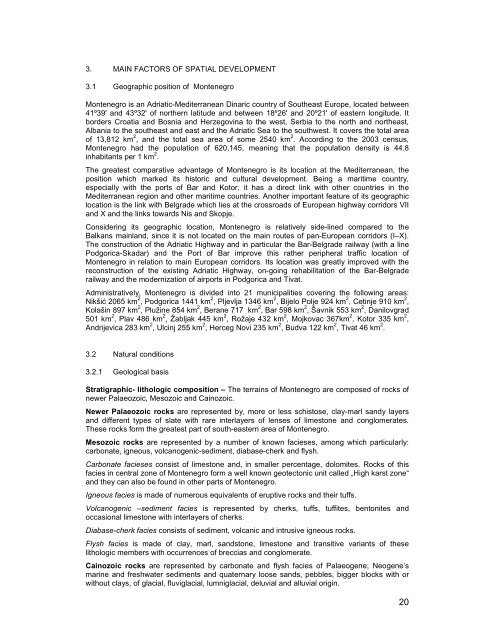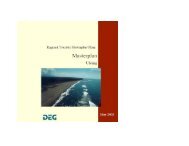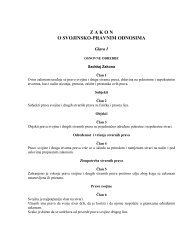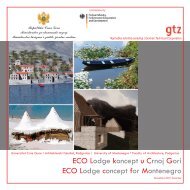Spatial plan of Montenegro until 2020 - Ada Bojana
Spatial plan of Montenegro until 2020 - Ada Bojana
Spatial plan of Montenegro until 2020 - Ada Bojana
You also want an ePaper? Increase the reach of your titles
YUMPU automatically turns print PDFs into web optimized ePapers that Google loves.
3. MAIN FACTORS OF SPATIAL DEVELOPMENT3.1 Geographic position <strong>of</strong> <strong>Montenegro</strong><strong>Montenegro</strong> is an Adriatic-Mediterranean Dinaric country <strong>of</strong> Southeast Europe, located between41º39' and 43º32' <strong>of</strong> northern latitude and between 18º26' and 20º21' <strong>of</strong> eastern longitude. Itborders Croatia and Bosnia and Herzegovina to the west, Serbia to the north and northeast,Albania to the southeast and east and the Adriatic Sea to the southwest. It covers the total area<strong>of</strong> 13,812 km 2 , and the total sea area <strong>of</strong> some 2540 km 2 . According to the 2003 census,<strong>Montenegro</strong> had the population <strong>of</strong> 620,145, meaning that the population density is 44.8inhabitants per 1 km 2 .The greatest comparative advantage <strong>of</strong> <strong>Montenegro</strong> is its location at the Mediterranean, theposition which marked its historic and cultural development. Being a maritime country,especially with the ports <strong>of</strong> Bar and Kotor, it has a direct link with other countries in theMediterranean region and other maritime countries. Another important feature <strong>of</strong> its geographiclocation is the link with Belgrade which lies at the crossroads <strong>of</strong> European highway corridors VIIand X and the links towards Nis and Skopje.Considering its geographic location, <strong>Montenegro</strong> is relatively side-lined compared to theBalkans mainland, since it is not located on the main routes <strong>of</strong> pan-European corridors (I–X).The construction <strong>of</strong> the Adriatic Highway and in particular the Bar-Belgrade railway (with a linePodgorica-Skadar) and the Port <strong>of</strong> Bar improve this rather peripheral traffic location <strong>of</strong><strong>Montenegro</strong> in relation to main European corridors. Its location was greatly improved with thereconstruction <strong>of</strong> the existing Adriatic Highway, on-going rehabilitation <strong>of</strong> the Bar-Belgraderailway and the modernization <strong>of</strong> airports in Podgorica and Tivat.Administratively, <strong>Montenegro</strong> is divided into 21 municipalities covering the following areas:Nikšić 2065 km 2 , Podgorica 1441 km 2 , Pljevlja 1346 km 2 , Bijelo Polje 924 km 2 , Cetinje 910 km 2 ,Kolašin 897 km 2 , Plužine 854 km 2 , Berane 717 km 2 , Bar 598 km 2 , Šavnik 553 km 2 , Danilovgrad501 km 2 , Plav 486 km 2 , Žabljak 445 km 2 , Rožaje 432 km 2 , Mojkovac 367km 2 , Kotor 335 km 2 ,Andrijevica 283 km 2 , Ulcinj 255 km 2 , Herceg Novi 235 km 2 , Budva 122 km 2 , Tivat 46 km 2 .3.2 Natural conditions3.2.1 Geological basisStratigraphic- lithologic composition – The terrains <strong>of</strong> <strong>Montenegro</strong> are composed <strong>of</strong> rocks <strong>of</strong>newer Palaeozoic, Mesozoic and Cainozoic.Newer Palaeozoic rocks are represented by, more or less schistose, clay-marl sandy layersand different types <strong>of</strong> slate with rare interlayers <strong>of</strong> lenses <strong>of</strong> limestone and conglomerates.These rocks form the greatest part <strong>of</strong> south-eastern area <strong>of</strong> <strong>Montenegro</strong>.Mesozoic rocks are represented by a number <strong>of</strong> known facieses, among which particularly:carbonate, igneous, volcanogenic-sediment, diabase-cherk and flysh.Carbonate facieses consist <strong>of</strong> limestone and, in smaller percentage, dolomites. Rocks <strong>of</strong> thisfacies in central zone <strong>of</strong> <strong>Montenegro</strong> form a well known geotectonic unit called „High karst zone“and they can also be found in other parts <strong>of</strong> <strong>Montenegro</strong>.Igneous facies is made <strong>of</strong> numerous equivalents <strong>of</strong> eruptive rocks and their tuffs.Volcanogenic –sediment facies is represented by cherks, tuffs, tuffites, bentonites andoccasional limestone with interlayers <strong>of</strong> cherks.Diabase-cherk facies consists <strong>of</strong> sediment, volcanic and intrusive igneous rocks.Flysh facies is made <strong>of</strong> clay, marl, sandstone, limestone and transitive variants <strong>of</strong> theselithologic members with occurrences <strong>of</strong> breccias and conglomerate.Cainozoic rocks are represented by carbonate and flysh facies <strong>of</strong> Palaeogene; Neogene’smarine and freshwater sediments and quaternary loose sands, pebbles, bigger blocks with orwithout clays, <strong>of</strong> glacial, fluviglacial, lumniglacial, deluvial and alluvial origin.20







